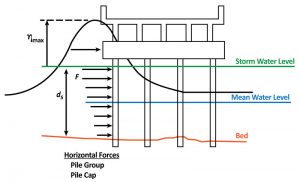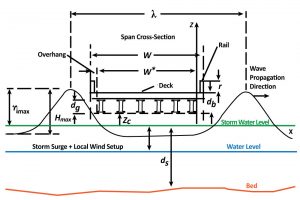Since 2004, there have been 10 hurricanes in the Atlantic Ocean that have each caused over $20 billion in damage. Since the late 1800s, sea levels have risen by 10 inches (250mm) and are expected to continue to rise, according to the National Aeronautics and Scape Administration (NASA). Because of this, Departments of Transportation, transit authorities, and private owners have decided it is necessary to add robustness and reliability to new and existing infrastructure, some of which are over 100 years old. Transportation infrastructure, in particular, is essential, as these weather events sometimes make it necessary to evacuate many people from large areas of the country, and the highway system is the primary evacuation route for most metropolitan areas. Additionally, emergency responders need to be able to move freely, maintaining access to as many areas as possible during and immediately after a storm event.
Bridges are one of the most vulnerable and critical components of the surface transportation network. A bridge that is out of service in normal conditions can result in long delays and significant detours. What is an inconvenience in normal times can become catastrophic in an emergency.
Major storm events impart loads on structures in several ways, resulting in varying degrees of damage. Wave action can push and lift the bridge, creating both global lateral and vertical forces. There are additional local impact loads where waves directly strike the bridge. Both flooding and wave action impart a vertical upwards force from buoyancy. The buoyant force can be enough to lift the bridge off its bearings and move it away from its supports. Floods with moving water can push debris against the side of the structure or deposit debris on top, which adds to the gravity loads. Barges and ships break free from their moorings in storm events and can impact bridge superstructures and substructures.
Most existing bridges were not designed for these additional loads and may not be able to resist them. The best chance of the structure’s survival in the event of an extreme storm is to prevent the structure from being subject to these loads, ideally by ensuring the bottom of the superstructure will be above the highest water or wave level. This is easier to accomplish on a new bridge as the approaching roadway profile can be set to accommodate the necessary bridge elevation. However, it can be difficult on an existing bridge where the travel profile may be set.
In 2000, Modjeski and Masters raised the Norfolk Southern Shellpot Swing span three feet to keep it out of the flood zone because the machinery used to operate the bridge was frequently flooded from high water events. Normally, a railroad would not be able to take a line out of commission for the time it would take to raise a span. However, this was an unusual situation in that the line was not in use and was being restored. The bridge was floated out on barges, the pier top elevations were increased by three feet, and new bearings were installed. The rehabilitated superstructure was floated back in place and put into service. The bridge has not experienced flood-related damage since.
While raising the bridge above the flood level is the best method to protect the superstructure, the substructure and foundation will still be subjected to flooding loads, and damage can still occur. Wave action and increased streamflow forces from trapped debris can cause increased loads on piers. Higher water flow velocities increase the likelihood of scour around foundations. Because these issues occur below the waterline, they are not easily or quickly identified. If no monitoring system is present, divers are used to confirm that bridges are safe to continue carrying traffic. However, there is a limited number of qualified underwater inspectors – and immediately after an extreme event, there may not be enough of them to service an area. Bridges that are designed to resist the loads from flood events and increased scour levels are less likely to be damaged. They will be less of a concern, reducing the risk of not having an inspection immediately after an event.
Movable bridges are used over navigable waterways when the vertical clearance below the bridge is inadequate for the size of the vessels that traverse the channel. This bridge type is particularly vulnerable to flood damage because their profile usually sets them close to the water, and they have sensitive machinery used to operate the bridge. These bridges are opened and closed for marine traffic with machinery that can be on the pier top or inside rooms designed into the piers. These spaces are not watertight once the water elevation is too high. If the machinery is flooded, the bridge will likely not be able to operate until, at minimum, it is repaired and, at worst, completely replaced.
The Florida Avenue Vertical Lift Bridge in New Orleans was opened to traffic in May of 2005. In August of 2005, the costliest hurricane on record for the United States, Hurricane Katrina, caused $125 billion in damage and over 1,200 deaths. New Orleans was in the direct path of the hurricane and suffered extreme damage. The Florida Avenue Bridge survived the storm, but the electrical operating system was severely damaged. Without a functioning operating system, the bridge could not be raised. This meant the waterway was blocked from allowing emergency supplies to be brought in by water. The US Army Corp of Engineers was prepared to demolish the three-month-old bridge to clear the navigable channel if it could not be made operational. Modjeski and Masters’ engineers were flown in by helicopter to assess the damage and attempt to make the bridge function. After two days of onsite trouble-shooting, the bridge was operating. It was able to be lifted, allowing marine traffic to resume and keeping the new bridge from being destroyed.
At the time the Florida Avenue Bridge was designed, there was little guidance for engineers to anticipate the types of loads caused by such an event. In 2008, the American Association of State Highway and Transportation Officials (AASHTO) released the Guide Specifications for Bridges Vulnerable to Coastal Storms. The specifications contain guidance for owners and designers on the design of bridges in coastal areas. Methods for calculating wave forces on both substructures and superstructures based on numerical simulations of wave passage under a bridge, including local impact forces, are provided in the guidelines. Physical wave tank tests and numerical simulations were used to develop the Physics-Based Method (PBM), which is used to calculate the forces and verify the results. Bridge failures due to storm surge and wave loading in Gulf Coast states provided field data that was used to verify results.
Loadings, as outlined in the Guide Specifications, are only one side of the design equation. The engineer must still address the resistance of the structure to the load. Various mitigation methods are used when it is not possible to raise the bridge above flood levels. Some methods can be installed as a retrofit to existing bridges, and others must be incorporated as part of the original design.
One failure mode observed in previous coastal storms is the unseating of the superstructure due to the combined effects of buoyancy and vertical wave loading. Air trapped in the areas between the beams can also add to the buoyancy effect. To significantly reduce the buoyancy, relatively small and frequently spaced holes that do not affect the structural integrity can be placed in the deck, allowing trapped air to escape. This can be done as a retrofit to existing bridges or as part of a new design. Alternatively, ensuring air can move longitudinally by not using solid diaphragms can also reduce the forces working to unseat the structure. Additionally, effectively tying the superstructure to the substructure through structural means can prevent unseating. However, the vertical loading – including the effects of impact from waves – can be very large and require robust tie-down systems, which may not be practical due to the requirement of the anchorage system placed into the concrete and limited space at the bearings.
In addition to the uplift forces, streamflow and wave effects cause increased horizontal loading. These loads can be high enough to push the bridge laterally off its supports. Lateral restraints at the bearings can be used to resist these forces. These can be added as a retrofit, but it is easier if they are added as part of the initial design. Another option for dealing with lateral loads is to reduce their magnitude by using castellated beams. The large holes designed into the webs of castellated beams create a load path that mimics that of a truss. These large holes significantly reduce the area of the beam, allowing the wave to pass through rather than impact on the surface.
Scour is the result of the increased stream flow velocity around bridge piers. Scour results when the flow velocity is high enough to move supporting soil out from under bridge foundations. Scour can occur even under base conditions; however, it is much more likely to occur in a flood event when flow velocity has significantly increased. In new designs, scour depths are predicted based on soil properties and streamflow velocity, which can be selected to reflect an extreme event. The foundation elements are then designed, assuming the scour has occurred. For existing structures that were not designed for scouring, armoring the soils around the piers with riprap can control the impacts. This has been proven to significantly mitigate the risk of scour, even in an extreme flood event.
Apart from storm events, flooding can also be caused by a tsunami. There are many similarities between the tsunami-generated loadings of structures and coastal storm loading. However, the nature of the waveforms can be very different, which changes the interaction between the structure and wave and results in significant enough differences in structural loading that additional guidelines are needed. Similar to other types of flood load mitigation, raising the superstructure above the top of the expected wave elevation is often the best option for a designer to consider, if at all practical. Efforts are currently underway to develop design guidance based on numerical and experimental studies of tsunami waves and their interaction with bridges for designers and owners considering this unique threat.
In conclusion, the existing transportation infrastructure – particularly bridges – is susceptible to damage from flooding and high-water events. Measures are being taken to retrofit existing structures and design new structures to make them more likely to survive these impacts. Research is ongoing to help better understand these events. Practicing design engineers should become familiar with published guidance, as part of their due diligence, to provide more robust and reliable designs.■


